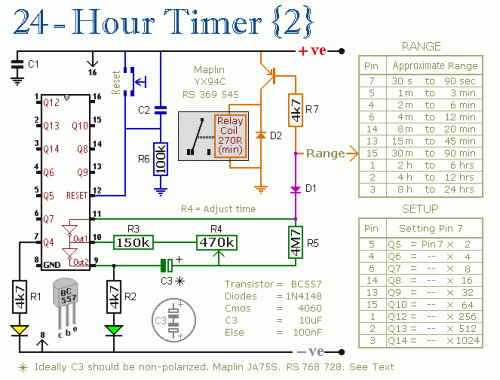Electronic projects |
|
|
|
24 Hour TimerDescription: Notes: The timer was designed for a 12-volt supply. However, provided a suitable relay is used, the circuit will work at anything from 5 to 15-volts. Applying power starts the timer. It can be reset at any time by a brief interruption of the power supply. The reset button is optional; but it should NOT be used during setup. The time it takes for the Yellow LED to light MUST be measured from the moment power is applied. Although R1, R2 and the two LEDs help with the setup, they are not necessary to the operation of the timer. If you want to reduce the power consumption, disconnect them once you've completed the setup. If you need a longer period than 24-hours, increase the value of C3. e-mail: web site: http://www.zen22142.zen.co.uk |
 Audio (49) Audio (49) Power & high voltage (43) Power & high voltage (43) Radio (23) Radio (23) Light & LED (31) Light & LED (31) Tools & measurement (40) Tools & measurement (40) Telephone (18) Telephone (18) Automotive (10) Automotive (10) Microcontrollers (12) Microcontrollers (12) Sensors & control (47) Sensors & control (47) Timers & oscillators (40) Timers & oscillators (40) Miscellaneous (26) Miscellaneous (26)All subcategories timer circuits oscillators 24 Second Shot Clock 28 LED Clock Timer 5 to 30 Minute Timer Amplifier Timer Asymmetric Timer Bedside Lamp Timer Dome Lamp Dimmer Jogging Timer NE555 Basic Monostable Periodic Timer Doorbell for the Deaf High Quality Intercom Combinational Conjuring Trick POT-PLANT POWER Ultrasonic Dog Whistle Quiz Circuit LED Torch Insect Repellant Speaker Microphone Circuit Magic Wand Conjuring Trick. Led display digital Voltmeter 500W low cost 12V to 220V inverter Low pass filter - Subwoofer High And Low Voltage Cut Off With Time Delay Metal Detector 2N3055 Power Amplifier Basic UPS Power Supply 200W audio amplifier LED Torch 100W RMS Amplifier DIY Electronics Projects  Promote Your Page Too |



